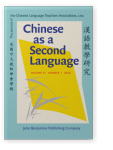Acquisition of time and locative phrases in Mandarin Chinese
A case of input saliency
In this study we explore the role played by input saliency in L2 acquisition of the time phrase and the locative phrase in Mandarin Chinese. In Chinese the time phrase that indicates when an event takes place and the locative phrase that indicates where an event takes place are similar in that neither can occur after the verb. L1 English L2 learners of Chinese have to learn to place both phrases pre-verbally. Our goal is to find out whether learners acquire the placement of the two types of phrases equally well. On the basis of input saliency measured in terms of form-function mapping and type frequency, we predicted that the time phrase will be easier to acquire than the locative phrase. We then conducted an experiment and put the hypothesis to test on learners at an early stage. The findings largely support our hypothesis: Simple time phrases are easier to acquire than simple locative phrases for beginning learners. In addition, the same group of learners had difficulty with both complex time phrases and complex locative phrases, suggesting that structural complexity also plays a role.
References
Collins, L., Trofimovich, P., White, J., Cardoso, W., & Horst, M
(
2009)
Some input on the easy/difficult grammar question: An empirical study.
Modern Language Journal, 931, 336–353.


Ellis, N.C
(
2002)
Frequency effects in language processing: A review with implications for theories of implicit and explicit language acquisition.
Studies in Second Language Acquisition, 241, 143–188.


Ellis, N.C
(
2006a)
Language acquisition as rational contingency learning.
Applied Linguistics, 271, 1–24.


Ellis, N.C
(
2006b)
Selective attention and transfer phenomena in L2 acquisition: Contingency, cue competition, salience, interference, overshadowing, blocking, and perceptual learning.
Applied Linguistics, 271, 164–194.


Goldschneider, J.M., & DeKeyser, R.M
(
2001)
Explaining the “natural order of L2 morpheme acquisition” in English: A meta-analysis of multiple determinants.
Language Learning, 511, 1–50.


Juffs, A
(
1998)
The acquisition of semantics-syntax correspondences and verb frequencies in ESL materials.
English Language Teaching, 21, 93–123.

Li, C., & Thompson, S
(
1981)
Mandarin Chinese: A functional reference grammar. Berkeley: University of California Press.

Liu, F
(
2009)
Aspect and the post-verbal zài phrases in Mandarin Chinese. In
J. Xing (Ed.),
Studies in Chinese linguistics: Functional approaches (pp. 103–129). Hong Kong: Hong Kong University Press.

Liu, Y., Yao, T.-C., Bi, N.-P., Ge, L., & Shi, Y
(
2009)
Integrated Chinese, Level 1 (Part 1 and Part 2), Textbook (3rd ed.). Boston, MA: Cheng & Tsui Company.

Liu, Y., Yao, T.-C., Bi, N.-P., Ge, L., & Shi, Y
(
2010)
Integrated Chinese, Level 2 (Part 1 and Part 2), Textbook (3rd ed.). Boston, MA: Cheng & Tsui Company.

MacWhinney, B
(Ed.) (
1987)
Mechanisms of language acquisition. Hillsdale, NJ: Lawrence Erlbaum Associates.

MacWhinney, B
(
1997)
Second language acquisition and the Competition Model. In
A.M.B. De Groot &
J.F. Kroll (Eds.),
Tutorials in bilingualism: Psycholinguistic perspectives (pp. 113–142). Mahwah, NJ: Lawrence Erlbaum Associates.

MacWhinney, B
(
2001)
The competition model: The input, the context, and the brain. In
P. Robinson (Ed.),
Cognition and second language instruction (pp. 69–90). New York: Cambridge University Press.


Wu, S.-M., Yu, Y., Zhang, Y., & Tian, W
(
2006)
Chinese link: Elementary Chinese. Upper Saddle River, NJ: Pearson Education.

Wu, S.-M., Yu, Y., Zhang, Y., & Tian, W
(
2008)
Chinese link: Intermediate Chinese. Upper Saddle River, NJ: Pearson Education.

Wulff, S., Ellis, N.C., Römer, U., Bardovi-Harlig, K., & LeBlanc, C
(
2009)
The acquisition of tense–aspect: Converging evidence from corpora and telicity ratings.
Modern Language Journal, 931, 354–369.


Cited by
Cited by 2 other publications
Huang, Dori & Johanna Watzinger‐Tharp
2024.
The use of cohesive devices as proficiency level discriminators in Chinese DLI learners' writing.
Foreign Language Annals 57:2
► pp. 472 ff.

Zhu, Junling
2023.
Critical Literature Review on Teaching Chinese as a World Language in the Context of Globalization.
Language and Sociocultural Theory 9:2

This list is based on CrossRef data as of 1 july 2024. Please note that it may not be complete. Sources presented here have been supplied by the respective publishers.
Any errors therein should be reported to them.
